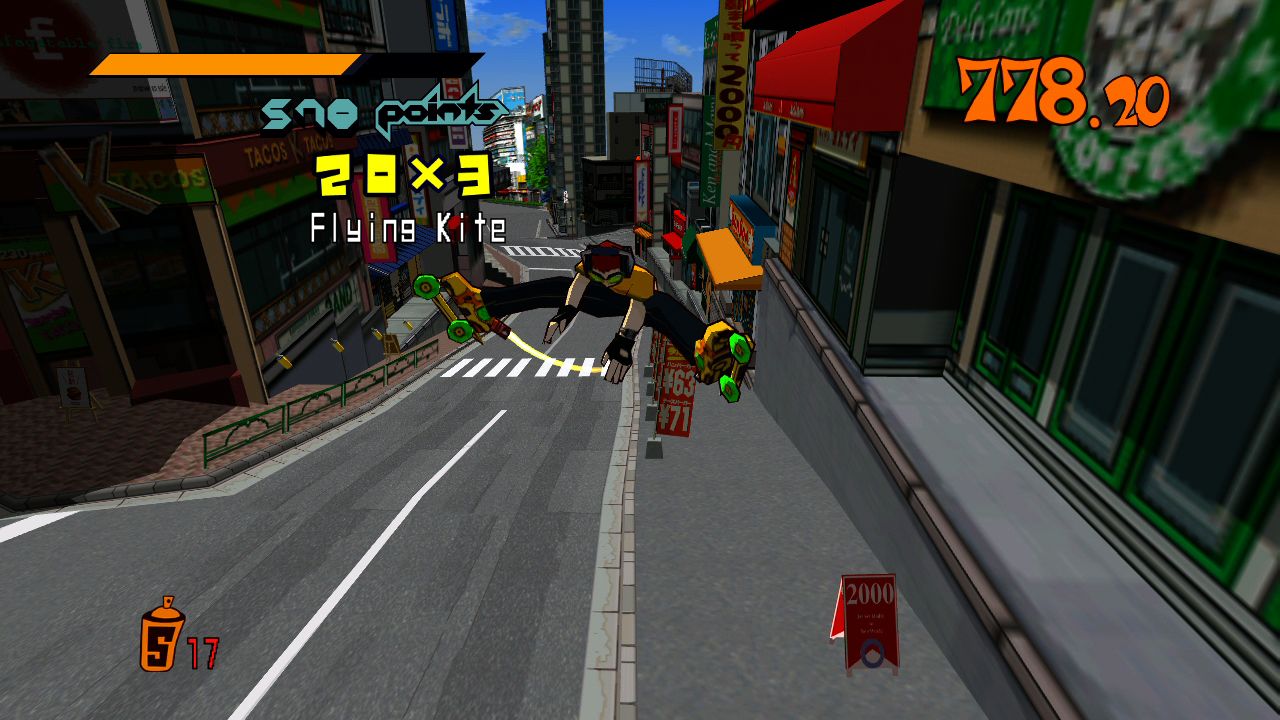Effectively a new genre, and a brand new aesthetic style with a great soundtrack, Jet Set Radio is one of the greats.
At the dawn of the new millennium, Sony had fundamentally changed the gaming landscape within the short time after they had released the PlayStation and as graphics improved, games moved towards a realism paradigm (which is not, necessarily realistic but tries to look like it) which was more "mature". Sega's Saturn had been pretty comprehensively routed in sales terms and they went back to the drawing board with the release of the Dreamcast which was far more powerful than the Sony PlayStation (but, crucially, not more than the PlayStation 2 that was to come) and designed to be easy to develop for and also a 3D capable machine. Sega's differentiation strategy was to draw on their arcade heritage (and ongoing success at the time) and bring those bright, bold colours to the home which was achieved with a string of arcade-perfect conversions such as Sega Rally 2 and Virtua Fighter 3.
In 1999, Sega developer Smilebit announced the remarkable looking Jet Set Radio - a cel-shaded (a term that had yet to really be defined) rollerblading game set in a cartoon Tokyo. It looked fantastic with bright, crisp images and a smooth animation style that popped out of the screen. That same year, Tony Hawk Pro Skater had made skateboarding games popular and this seemed to ride on that with a simple copy but with some extra Japanese craziness. This turned out to be not quite right as the trick mechanic seemed to be massively downgraded and the game a shallow facsimile. Except, those preconceptions were not right at all - this had little to do with the Tony Hawk gameplay - this was a classic Sega combination of score attack and arcade simplicity made whole with clever, tight design. Tricks and suchlike were not the meat of the game - you could play without tricks at all but they were there for you to enjoy if you felt like it. Entirely superfluous and vital at the same time. In order to complete a level, you had to "tag" with graffiti a set number of sites around the level within a time limit. As you tag more areas, the level of defence from the police and other gangs increases so you have to plan your route to avoid them where possible. At the time, it was a game that I felt was was both fundamentally retro in nature yet also cutting edge[1]. It revolved around learning the simple mechanic, and then learning the map and putting together a strategy that allowed you to get all tasks done effectively and efficiently - and in that sense it reminded me a lot of the criminally underrated Nights. There were no power ups, there was no emotive progression of your characters with unlocked skills etc - this was a clear case of level design showing progress. And, actually, many of the levels were recycled as you revisited areas but when you design them well, they don't get tired. Based on areas of real life Tokyo but not slavishly copied allowed the designers to get the feel for the space (as I found when I got lost once, in Shibuya) and keep design appropriate for the gameplay. I wish that this method, rather than copying real life, was a method used more often.
The very first level set up as a tutorial sets the game up very well with the ideas of speed, combo chains and grinding set up well enough in a bus station level. The tutorial introduces all of the concepts of the game and asks you to create quite a long "chain" by grinding and jumping over a number of railings until you realise that there is an infinite loop there and that sets the whole of the game up to be one of spotting opportunities.
Arguably, this was the Dreamcast's finest hour - the game that there was never a competitor for, in any way, on any other console[2] and that was kind of indicative of the problem. A problem that Sega never overcame and would, in my opinion, eventually overwhelm the Japanese games industry. The problem being that tight, repeatable design was on the way out[3] to be replaced by sprawling, open worlds. And the reason there was no competition was that it was not selling - great games developed into a cul de sac - a beautiful, playable cul de sac.
The soundtrack, by Hideki Naganuma and largely created in-house (as was usually the case then) is genuinely exceptional with a smattering of licensed tracks, such as Improvise by Jurassic 5, adding to the variety and quality. From a technical, artistic standpoint, this is a truly coherent whole.Jak & Daxter - 3D platformer series in the Mario mould.
Jungle Strike - The isometric helicopter genre did not have many more instalments - even though EA love franchises.
Jet De GO! - An airliner simulator based on the Densha de GO! Model, which is less unfairly maligned.
1. In fact, I bought this, rather shamefully, within the Dreamcast death rattle phase when you could buy it with four games included for a small sum. There were some great games available and it is a real shame that the potential of the PlayStation effectively killed the realised potential of a group of developers at the heights of their powers. The Dreamcast remains a beacon of hope, and despair, in the history of the industry. Its failure destroyed Sega as it tried to reach beyond what it could and soon, you could buy Sega games on Nintendo hardware - a previously ridiculous proposition.↩
2. The sequel, Jet Set Radio Future was released on the Microsoft XBox.↩
3. It would return, eventually, in the form of the ubiquitous online battle arenas that FPS games would make their own.↩
No comments:
Post a Comment